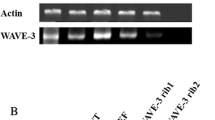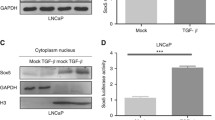Abstract
Steroid 5-alpha reductase type 2 (SRD5A2) gene is important for normal development and functioning of prostate gland but it is reported to be silenced in metastatic prostate cancer. We showed that exogenous SRD5A2 expression in prostate cancer cell line reduced cell migration and invasion. Additionally, the stable transfectants showed enhanced adhesion to the matrix accompanied by changes in cytoskeletal organization, involving actin polymerization. siRNA knockdown of the endogenous SRD5A2 mRNA in LnCAP cells was effective, it reversed the phenotype, and thus induced cell motility. The MEK1 and pERK1/2 levels were found to be reduced in SRD5A2-expressing cells. Further, the reduced level of p38 protein was correlated with low expression of MMP-2 and MMP-7 genes. The results suggest that SRD5A2 controls cell migration by indirectly regulating ERK/MAPK pathway.





Similar content being viewed by others
References
Andersson S, Bishop RW, Russell DW (1989) Expression cloning and regulation of steroid 5 alpha-reductase, an enzyme essential for male sexual differentiation. J Biol Chem 264(27):16249–16255
Andersson S et al (1991) Deletion of steroid 5 alpha-reductase 2 gene in male pseudohermaphroditism. Nature 354(6349):159–161
Thigpen AE et al (1992) Molecular genetics of steroid 5 alpha-reductase 2 deficiency. J Clin Investig 90(3):799–809
Russell DW, Wilson JD (1994) Steroid 5 alpha-reductase: two genes/two enzymes. Annu Rev Biochem 63:25–61
Titus MA et al (2005) Steroid 5alpha-reductase isozymes I and II in recurrent prostate cancer. Clin Cancer Res 11(12):4365–4371
Thomas LN et al (2003) 5alpha-reductase type 1 immunostaining is enhanced in some prostate cancers compared with benign prostatic hyperplasia epithelium. J Urol 170(5):2019–2025
Thomas LN et al (2005) Differential alterations in 5alpha-reductase type 1 and type 2 levels during development and progression of prostate cancer. Prostate 63(3):231–239
Habib FK et al (2003) The loss of 5alpha-reductase type I and type II mRNA expression in metastatic prostate cancer to bone and lymph node metastasis. Clin Cancer Res 9(5):1815–1819
Bjelfman C et al (1997) Differential gene expression of steroid 5 alpha-reductase 2 in core needle biopsies from malignant and benign prostatic tissue. J Clin Endocrinol Metab 82(7):2210–2214
Soderstrom TG et al (2001) Messenger ribonucleic acid levels of steroid 5 alpha-reductase 2 in human prostate predict the enzyme activity. J Clin Endocrinol Metab 86(2):855–858
Kosaka T et al (2013) Human castration resistant prostate cancer rather prefer to decreased 5alpha-reductase activity. Sci Rep 3:1268
Titus MA et al (2014) 5alpha-reductase type 3 enzyme in benign and malignant prostate. Prostate 74(3):235–249
Gormley GJ et al (1990) Effects of finasteride (MK-906), a 5 alpha-reductase inhibitor, on circulating androgens in male volunteers. J Clin Endocrinol Metab 70(4):1136–1141
Feneley MR et al (1999) A prospective randomized trial evaluating tissue effects of finasteride therapy in benign prostatic hyperplasia. Prostate Cancer Prostatic Dis 2(5/6):277–281
Span PN et al (1999) Selectivity of finasteride as an in vivo inhibitor of 5alpha-reductase isozyme enzymatic activity in the human prostate. J Urol 161(1):332–337
Clark RV et al (2004) Marked suppression of dihydrotestosterone in men with benign prostatic hyperplasia by dutasteride, a dual 5alpha-reductase inhibitor. J Clin Endocrinol Metab 89(5):2179–2184
Rittmaster R et al (2008) Effect of dutasteride on intraprostatic androgen levels in men with benign prostatic hyperplasia or prostate cancer. Urology 72(4):808–812
Andriole G et al (1995) Treatment with finasteride following radical prostatectomy for prostate cancer. Urology 45(3):491–497
Paller CJ, Smith TJ (2012) Finasteride and prostate cancer: a commentary. Oncologist 17(7):888–890
Shah SK et al (2009) Phase II study of dutasteride for recurrent prostate cancer during androgen deprivation therapy. J Urol 181(2):621–626
Dogra N, Mukhopadhyay T (2012) Impairment of the ubiquitin-proteasome pathway by methyl N-(6-phenylsulfanyl-1H-benzimidazol-2-yl)carbamate leads to a potent cytotoxic effect in tumor cells: a novel antiproliferative agent with a potential therapeutic implication. J Biol Chem 287(36):30625–30640
Nakamura S, Roth JA, Mukhopadhyay T (2000) Multiple lysine mutations in the C-terminal domain of p53 interfere with MDM2-dependent protein degradation and ubiquitination. Mol Cell Biol 20(24):9391–9398
Parsons JT, Horwitz AR, Schwartz MA (2010) Cell adhesion: integrating cytoskeletal dynamics and cellular tension. Nat Rev Mol Cell Biol 11(9):633–643
Zaidel-Bar R et al (2003) Early molecular events in the assembly of matrix adhesions at the leading edge of migrating cells. J Cell Sci 116(Pt 22):4605–4613
Yamazaki D, Kurisu S, Takenawa T (2005) Regulation of cancer cell motility through actin reorganization. Cancer Sci 96(7):379–386
Olson MF, Sahai E (2009) The actin cytoskeleton in cancer cell motility. Clin Exp Metastasis 26(4):273–287
Rottner K, Stradal TE (2011) Actin dynamics and turnover in cell motility. Curr Opin Cell Biol 23(5):569–578
Sun J et al (2011) Fascin protein is critical for transforming growth factor beta protein-induced invasion and filopodia formation in spindle-shaped tumor cells. J Biol Chem 286(45):38865–38875
Viala E, Pouyssegur J (2004) Regulation of tumor cell motility by ERK mitogen-activated protein kinases. Ann N Y Acad Sci 1030:208–218
Choi C, Helfman DM (2014) The Ras-ERK pathway modulates cytoskeleton organization, cell motility and lung metastasis signature genes in MDA-MB-231 LM2. Oncogene 33(28):3668–3676
Pergolizzi RG et al (1993) Mutational status of codons 12 and 13 of the N- and K-ras genes in tissue and cell lines derived from primary and metastatic prostate carcinomas. Cancer Investig 11(1):25–32
Acknowledgments
This work was supported by the grants from the University Grants Commission and Indian Council of Agricultural Research, Government of India (to TM) and research fellowship from the Council of Scientific and Industrial Research, Government of India (to SA).
Author information
Authors and Affiliations
Corresponding author
Electronic supplementary material
Below is the link to the electronic supplementary material.
Rights and permissions
About this article
Cite this article
Aggarwal, S., Singh, M., Kumar, A. et al. SRD5A2 gene expression inhibits cell migration and invasion in prostate cancer cell line via F-actin reorganization. Mol Cell Biochem 408, 15–23 (2015). https://doi.org/10.1007/s11010-015-2478-z
Received:
Accepted:
Published:
Issue Date:
DOI: https://doi.org/10.1007/s11010-015-2478-z




